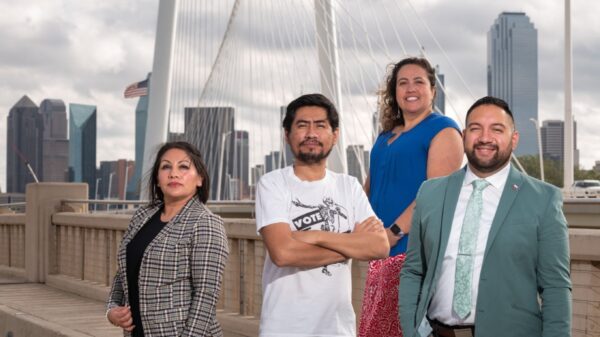BY EPICENTER-NYC
New York City Mayor Eric Adams was in
El Paso, Texas, this weekend, on a sort of bizarre official trip to another city to talk about an issue that’s affecting his own: the arrival of asylum seekers. Adams toured around the border and held a press conference where he bemoaned the fact that some 40,000 migrants have arrived in the city since last year, many sent as a political stunt by officials in other states. He called on the federal government to intervene, including with funding.
Adams’ entreaties are vague enough that they’re a bit of a Rorschach test for how the listener wants to handle immigration.
Adams’ entreaties are vague enough that they’re a bit of a Rorschach test for how the listener wants to handle immigration. His most common refrain is to ask the federal government to “do your job” when it comes to management of immigration, which, depending on who’s listening, could mean doubling down on Title 42 and further shutting down the border to humanitarian migration, having a national strategy to relocate migrants to localities with capacity and funding to receive them, shifting laws to make it easier for them to work, or all of the above.
In that regard, the mayor’s pronouncements on this are actually a pretty perfect window into the way that a lot of more moderate liberals think about humanitarian immigration. They don’t necessarily know how all the mechanics work under the hood, but they hold two general attitudes in conflict: that migrants should be welcomed, assisted, and treated with respect, and that some significant portion of them are essentially gaming the system that exists, that their cases should be decided quickly and ideally without them having to alight in American cities, and that having large volumes of people requesting asylum in the United States is somehow a federal policy failure that can and should be remedied.
Examining policy failures
Let’s take that latter sentiment step by step. First of all, in a world where efficiency, speed, and innovation are the buzzwords of choice for business and government, there’s a lot of frustration over the fact that asylum cases move so glacially. There are definite bureaucratic and fixable reasons for this, not least that applications made at the border, which are known as defensive applications given that they’re a defense against a deportation case, are still mostly thrown into the adversarial and drawn-out setting of a court fight. This isn’t the only way to do this, as evidenced by the fact that the government has actually already
rolled out an alternative in the form of giving initial jurisdiction of defensive cases to the U.S. Citizenship and Immigration Services instead of the courts, but it is very limited in scope so far.
That said, there’s a limit to how fast cases can go, and how easily rejections can be handed down, and that’s by the very nature of what an asylum process is supposed to be. As we’ve noted before, asylum law very explicitly states that people can file asylum applications regardless of their manner of entry into the country and current status, i.e. even people who crossed the border illegally by law should have the ability to make an asylum claim (in practice, of course, this doesn’t always pan out, as most clearly exemplified by the use of Title 42). The first steps in such a claim, namely the credible fear interviews, are by design pretty low bars to clear, and the rest of the proceedings are complex and tend to involve extensive, detailed evidence and documentation.
Put simply, the reason for this is the recognition that these are fundamentally life-or-death cases. Erroneously sending someone back to a country of origin can be a death sentence, and making those sorts of determinations is messy. To qualify for asylum, someone has to prove that they are facing or will almost certainly face persecution on the basis of race, religion, nationality, membership in a particular social group, or political opinion, which can get very complicated depending on the interlocking factors at play. A society might be generally hostile to, for example, people of a certain religious minority, but it’s a different animal to prove that you have been or are likely to be persecuted individually, in a way that the government either condones or is at least uninterested or powerless to prevent. Trying to speed these cases through can be and
indeed has been a disaster for due process.
the administration has also failed spectacularly to even come close to hitting the refugee caps it’s set for the past two fiscal years, keeping refugee admissions at the lowest levels in decades,
Asylum cases move slowly through the system
So if there’s a limit to how fast these cases can go, why do the applicants have to come and initiate thousands of proceedings here? Why don’t they apply from elsewhere? Well, the law itself requires that people be physically present in the U.S.
before they can file an asylum claim, and for a huge chunk of the world, the only way to do that is to show up at the border; generally speaking, you can’t board any type of vessel bound for the U.S. if you don’t already have entry documentation. There is, of course, a refugee program with identical qualifying standards to asylum, but contrary to popular belief, you can’t apply for it directly. You have to be referred by a third party, usually the United Nations, and that means there has to be an infrastructure in place to make those referrals.
The refugee program is also, for obvious reasons, not designed to put you through years of applications while you’re
still in the place where you’re in danger, but already a third country. As we
detailed recently, the administration has also failed spectacularly to even come close to hitting the refugee caps it’s set for the past two fiscal years, keeping refugee admissions at the lowest levels in decades, so insofar as the refugee system is another option, it hasn’t proved to be a particularly robust or accessible one for anyone, let alone the Venezuelans and Central Americans that have made up the bulk of recent asylum applicants.
How about alternatives to these humanitarian programs, then? There aren’t really any viable ones. Lately, the Biden administration has been leaning heavily on humanitarian parole, but, as
we’ve exhaustively detailed, that is a terrible replacement for asylum. Aside from the fact that it’s not really serving the same populations, it’s a discretionary, nonpermanent, and rather flimsy status that can be renewed but never converted to permanent status, unlike asylum’s pretty straight shot to residency. The more people are added to the rolls of parole, the bigger that unresolved issue becomes.
Alright, so how about people being allowed to make the applications, but then waiting elsewhere? That’s actually also been tried, to disastrous effects.
Read more at the Epicenter website.










You must be logged in to post a comment Login